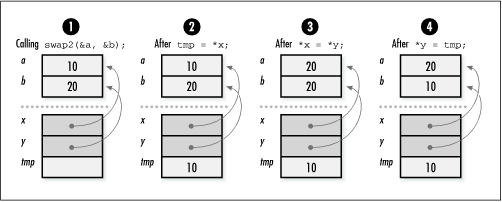Pointers as Parameters to Functions
Pointers are an essential part of calling functions in C. Most importantly, they are used to support a type of parameter passing called call-by-reference. In call-by-reference parameter passing , when a function changes a parameter passed to it, the change persists after the function returns. Contrast this with call-by-value parameter passing, in which changes to parameters persist only within the function itself. Pointers are also an efficient means of passing large amounts of data in and out of functions, whether we plan to modify the data or not. This method is efficient because only a pointer is passed instead of a complete copy of the data. This technique is used in many of the examples in this book.
Call-by-Reference Parameter Passing
Formally, C supports only call-by-value parameter passing. In call-by-value parameter passing , private copies of a function’s calling parameters are made for the function to use as it executes. However, we can simulate call-by-reference parameter passing by passing pointers to parameters instead of passing the parameters themselves. Using this approach, a function gets a private copy of a pointer to each parameter in the caller’s environment.
To understand how this works, first consider swap1, which illustrates an incorrect implementation of a function to swap two integers using call-by-value parameter passing without pointers. Figure 2.4 illustrates why this does not work. The function swap2 corrects the problem by using pointers to simulate call-by-reference parameter passing. Figure 2.5 illustrates how using pointers makes swapping proceed correctly.
Incorrect Swap | Correct Swap |
void swap1(int x, int y) {
int tmp;
tmp = x; x = y; y = tmp;
return;
} | void swap2(int *x, int *y) {
int tmp;
tmp = *x; *x = *y; *y = tmp;
return;
} |
One of the nice things about C and call-by-reference parameter passing is that the language gives us complete control over exactly how parameter passing is performed. One disadvantage, however, is that this control can be cumbersome since we often end up having to dereference call-by-reference parameters numerous times in functions.
Another use of pointers in function calls occurs when we pass
arrays to functions. Recalling that C treats all array names
transparently as unmodifiable pointers, passing an array of objects
of type T in a function is equivalent to
passing a pointer to an object of type T.
Thus, we can use the two approaches interchangeably. For example,
function f1 and function
f2 are equivalent.
Array Reference | Pointer Reference |
int f1(int a[]) {
a[0] = 5;
return 0;
} | int f2(int *a) {
*a = 5;
return 0;
} |
Usually the approach chosen depends on a convention or on wanting to convey something about how the parameter is used in the function. When using an array parameter, bounds information is often omitted since it is not required by the compiler. However, including bounds information can be a useful way to document a limit the function imposes on a parameter internally. Bounds information plays a more critical role with array parameters that are multidimensional.
When defining a function that accepts a multidimensional array, all but the first dimension must be specified so that pointer arithmetic can be performed when elements are accessed, as shown in the following code:
int g(int a[][2]) {
a[2][0] = 5;
return 0;
}To understand why we must include all but the first dimension, imagine a two-dimensional array of integers with three rows and two columns. In C, elements are stored in row-major order at increasing addresses in memory. This means that the two integers in the first row are stored first, followed by the two integers in the second row, followed by the two integers of the third row. Therefore, to access an element in any row but the first, we must know exactly how many elements to skip in each row to get to elements in successive rows (see Figure 2.6).
Pointers to Pointers as Parameters
One situation in which pointers are used as parameters to
functions a great deal in this book is when a function must modify a
pointer passed into it. To do this, the function is passed a
pointer to the pointer to be modified. Consider
the operation list_rem_next, which Chapter 5 defines for removing an
element from a linked list. Upon return,
data points to the data removed from the
list:
int list_rem_next(List *list, ListElmt *element, void **data);
Since the operation must modify the pointer
data to make it point to the data
removed, we must pass the address of the pointer
data in order to simulate
call-by-reference parameter passing (see Figure 2.7). Thus, the operation takes a
pointer to a pointer as its third parameter. This is typical of how
data is removed from most of the data structures presented in this
book.




